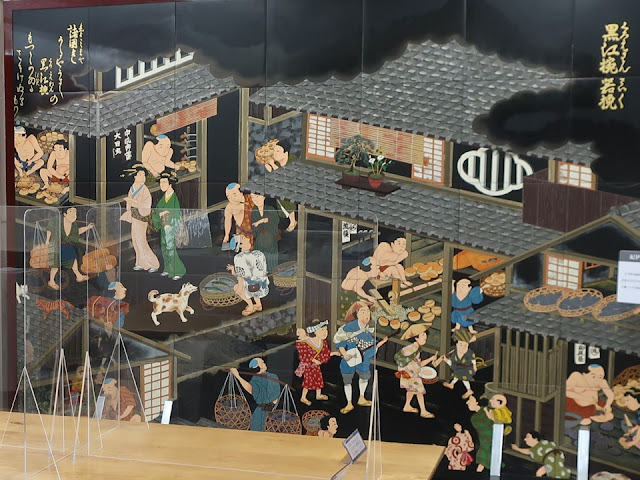Kainan in Wakayama prefecture is around 70 km south of the central Osaka. There are abundant explanations beside the exhibits. I took photos under the approval of the museum.
和歌山県北部の海沿い、海南市にある資料館です。大量の説明文が付けられています。許可を得て撮影しました。
Stone signposts are exhibited beside the entrance. Those show the ways to Kumano, Kouyasan and Ryujin.
入口の左には、熊野街道、龍神街道、高野街道の道しるべが置かれています。
I’ll highlight some from many exhibits. It is interesting that there are leaflets beside some of the exhibits which tell us the narratives of their backgrounds and so on. The hanging scrolls at inner most were drawn by Aoki Baigaku (1866-1947) who died in Kainan.
展示品と説明がてんこ盛りですので、その中からピックアップします。いくつかの展示には「○○のストーリ(物語)」というパンフレットが置かれており、展示品に親しみを持てます。奥の軸は青木梅岳(1866-1947)の作です。
Kuroe in Kainan city is a production center of lacquerware.
海南市・黒江は紀州漆器の生産地です。
Kuroe craftsmen were depicted in the guidebook (copY9 issued in the Edo period (1603~1868).
「紀伊国名所図会」(複写)には、町で漆器を作る人たちが描かれています。
At Uruwashi-Kan (Traditional Kishu Lacquerware Industry Center), there is a same picture of Kuroe craftsmen. It is lacquerware. Lacquerware made the picture so luxurious. It is written in the old guidebook, “Kuroe is a prosperous town. Many buildings of workshops and stores are crammed. There is no space to put a drill bit.”
市内のうるわし館(紀州漆器伝統産業館 うるわし館)に同じ絵を漆で作った大きな展示品があります。漆にすると豪華ですね。展示の説明(一つ目の写真)に書かれている「工商軒を連ねて、錐を立つる間もなく繁盛豊饒の地」というのがよく分かります。
Wakanoura bay has been famous for its scenic beauty. A well-known poet among Japanese people (Kakinomoto no Hitomara) in the 7th century created a poem here. It was designated as Japanese Heritage in 2017. Special exhibition about Wakanoura was held when I visited.
Reference site: https://wakanoura-nihonisan.jp/en/
和歌の浦の光景は柿本人麻呂の時代から歌に残されています。2017年に日本遺産に認定されました。訪問時に特別展として展示されていました。
It is the section of a flood-control engineer (Izawa Yasobe, 1663-1738). After the daimyo lord of the region was promoted as the 8th shogun, he summoned Izawa, who was already sixty, to Edo (old name of Tokyo). He was in charge of flood-control near Tokyo; what a great man!
井澤弥惣兵衛(1663-1738)という治水技術者がいました。60歳の時に、将軍になった紀州藩出身の吉宗に召され、見沼用水路の開削(埼玉県)などに携わりました。「紀州流土木工法を駆使し」と書かれています。
Official website: https://www.city.kainan.lg.jp/shiseijoho/shiyakusho/sisetusyosai/shiryokan.html (in Japanese), accessed in December, 2023
Visited in March, 2023
The GDP of Wakayama prefecture is 38th in 47 prefectures; it’s a plain one, sorry to say. However, the 5th biggest han (feudal domain) was there in the Edo period (1603~1868).
People in the other region have visited Kumano shrines since the ancient era. Local people have developed techniques of whaling, cultivating Ume (Japanese plum) and planting Mikan (mandarin orange). They also have developed brand lacquerware using local trees. After my trip of the coast of Kiii Peninsula, I have found its rich history and industries. It's a nice place to visit, I'm sure.
和歌山県のGDPは、47都道府県中38位(2022年)、ぱっとしない感じですが、江戸時代は約55万石(伊勢志摩を含むので紀伊国は37万石)で石高第五位の大藩がありました。
古くは熊野詣で人々が訪れ、捕鯨や梅作り、ミカン作りの技術を磨き、林業では紀州材のブランド漆器を作りました。海岸沿いを旅してみて、その歴史と産業の豊かさに気づきました。 いいところです。
Reference articles about Kishu、紀伊半島の記事
Uruwashi-Kan(Traditional Kishu Lacquerware Industry Center)、紀州漆器伝統産業館 うるわし館
Jin-Buro
Museum in Yuasa town、甚風呂(銭湯跡歴史資料館)と湯浅町(和歌山県)
MINABE
Town UME Promotion Museum、みなべ町うめ振興館
Taiji
Whale Museum、太地町立くじらの博物館
Boki-do
cave bath (Hotel Urashima)、忘帰洞(ホテル浦島)
Kumano
Nachi Taisha (shrine)、熊野那智大社
Shingu
history and folklore museum、新宮市立歴史民俗資料館
Matoya
Bay and Shima city history and folklore museum、的矢湾と志摩市歴史民俗資料館
Toba
Sea-Folk Museum (1/3)、鳥羽市立海の博物館 (part1)
Toba
Sea-Folk Museum (2/3)、鳥羽市立海の博物館 (part2)
Toba
Sea-Folk Museum (3/3)、鳥羽市立海の博物館 (part3)
Nanki
Kumano Geopark、南紀熊野ジオパーク
Previous post (museum in the same city): Uruwashi-Kan(Traditional Kishu Lacquerware Industry Center)、紀州漆器伝統産業館 うるわし館
Next post (museum in mountainous area, Nagano prefecture of central Japan): Museum of Mochizuki History、望月歴史民俗資料館








Comments
Post a Comment